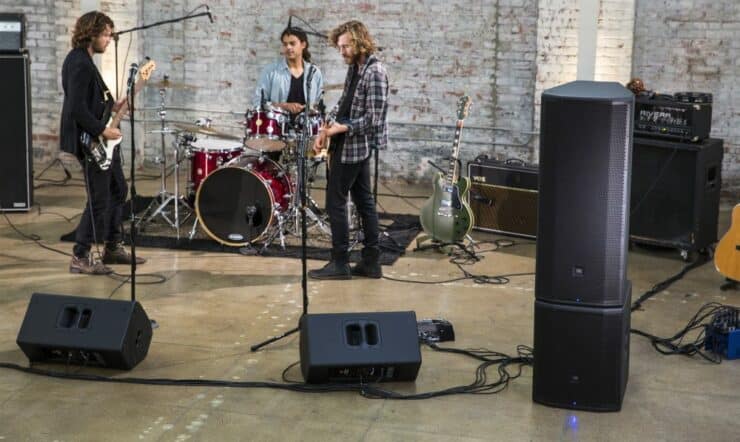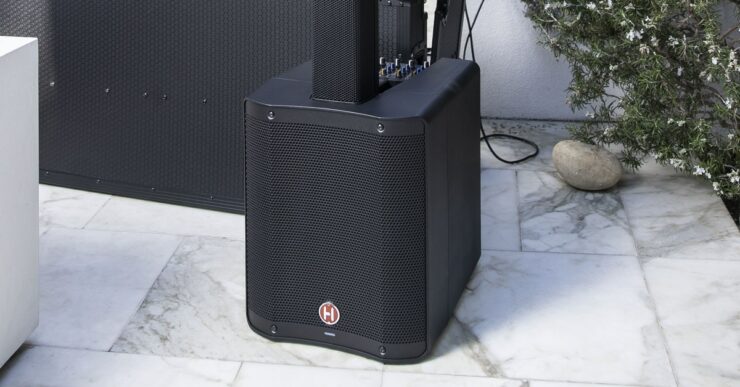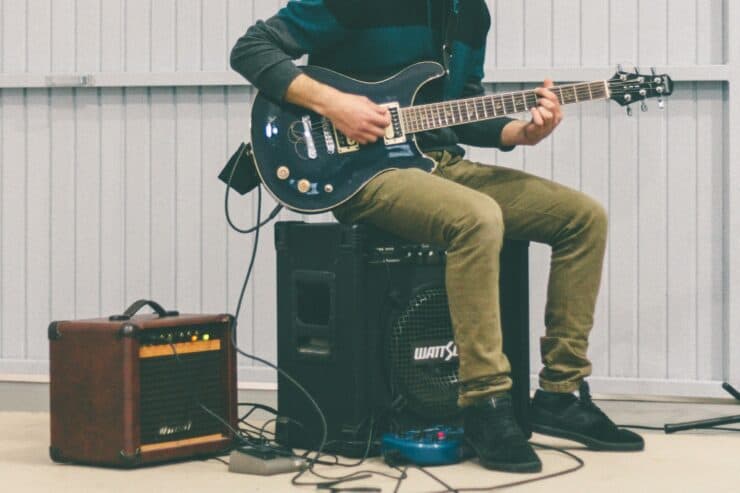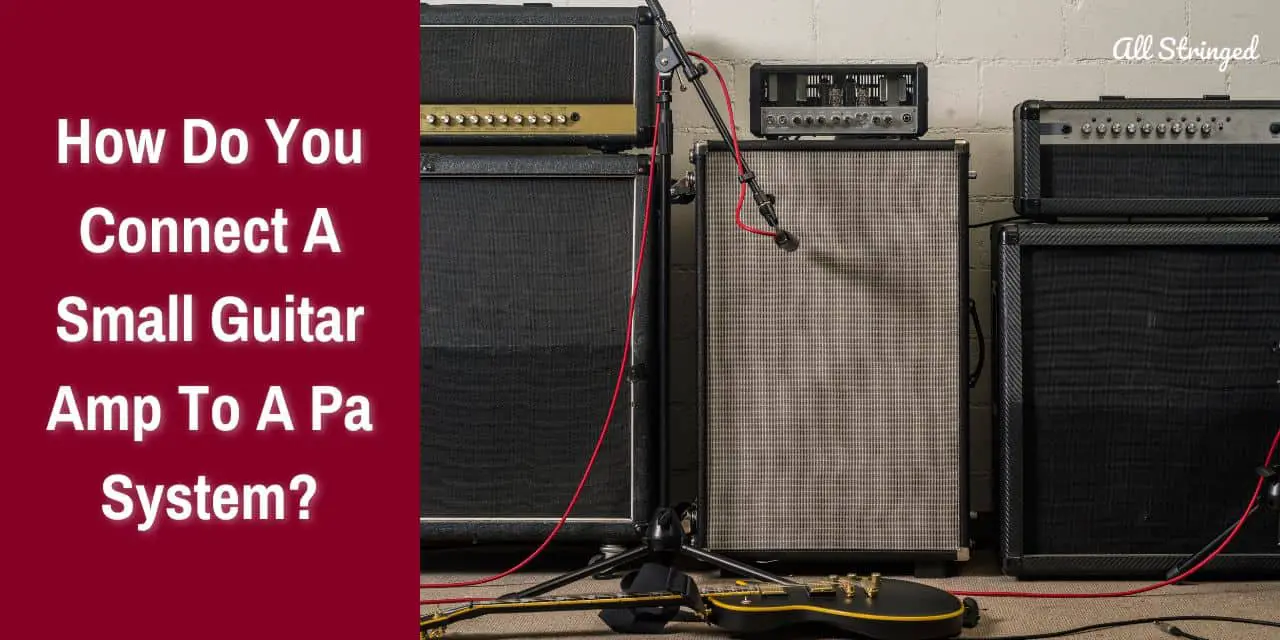Are you a guitar player who wants to learn how to connect a small guitar amp to a PA system? Look no further! In this article, we’ll walk you through the process step by step, from equipment setup to testing. We’ll also discuss the benefits of connecting a small guitar amp to a PA system and answer any additional questions you may have. Whether you’re a beginner or an experienced guitarist, this article is sure to give you the information you need to make a successful connection. So let’s get started!
Overview of PA systems
PA systems or also known as Public Address systems are widely used in various settings for amplifying sound and ensuring clear communication to a large audience. Whether in schools, stadiums, concert venues, or corporate events, PA systems play a key role in delivering speeches, announcements, music, and other audio content to a broad range of listeners.
Definition of PA systems
A PA system or Public Address system essentially refers to a collection of audio equipment designed to amplify the sound and distribute it over a wide area. Its primary purpose is to transmit clear and intelligible audio to a large audience, ensuring that the sound, message, or performance reaches all listeners effectively. PA systems are used in various applications, ranging from small-scale musical setups for small gigs to large-scale systems for big concerts.
>>> Click here to read our review about the Top 15 Best Small Guitar Amps <<<
Benefits of using a PA system with a guitar amp
A PA system is designed for amplifying audio sources, including vocals, instruments, and music playback. It consists of several components, working together to capture, amplify, and distribute sound. When used in conjunction with a guitar amp, a PA system will help in enhancing the overall sound by providing greater coverage, clarity, and balance.
Here are some of the benefits of using a PA system with a guitar amp –
#1. Increased sound projection
PA systems have larger and more efficient speakers than most guitar amps. By combining the guitar amp’s sound with the PA system, you’ll be able to achieve a broader and more far-reaching sound projection, ensuring that your guitar sound reaches every corner of the venue.
#2. Improved clarity and balance
They are designed for reproducing sound accurately and evenly across the frequency spectrum. This helps in maintaining clarity and balance in the mix, allowing your guitar to blend seamlessly with other instruments and vocals. The PA system will help overcome potential frequency imbalances or issues that might arise from the guitar amp alone.
#3. Versatility and flexibility
PA systems also provide greater flexibility in terms of adjusting volume levels and EQ settings. This allows for better control over the overall mix, ensuring that your guitar sound can be optimized for different venues and performance situations. Moreover, PA systems often offer additional inputs for other audio sources, allowing you to expand your sonic possibilities during live performances.
Different components of a PA system
When it comes to amplifying the guitar’s sound, the combination of a guitar amp and a PA system can take your performance to new heights. The integration of these two powerful tools allows for wider sound dispersion, increased projection, and the ability to reach larger audiences. Here are the different components of a PA system –

#1. Microphones
Microphones are essential input devices that convert sound into electrical signals. They capture the audio source like a speaker’s voice or musical instruments, and transmit it to the PA system for amplification and distribution. Different types of mics, including condenser, dynamic, and wireless can be used depending on the specific application and venue requirements.
#2. Mixers
Mixers serve as the control center of a PA system. They allow the users to adjust the audio levels, balance multiple audio sources, apply equalization, and add effects if needed. Mixers receive the signals from microphones, instruments, and other audio sources, and then route them to the appropriate output channels for amplification.
#3. Small guitar amps
Amplifiers are responsible for increasing the strength of audio signals from lie level to a level suited for driving speakers. They receive the audio signals from the mixer and then boost them to a sufficient power level to drive the speakers effectively. Small guitar amps such as Boss, Fender, Blackstar, Yamaha etc. come in different power ratings and configurations to accommodate the specific requirements of the PA system setup.
#4. Speakers
Speakers are the output devices in a PA system. They are responsible for converting the electrical signals from the small guitar amp back into audible sound waves. PA speakers are designed for projecting sound over a wide area and are available in various types, including passive speakers and powered speakers.
#5. Signal processors
Signal processors are optional components that enhance the audio quality or add specific effects to the sound. These devices include equalizers, limiters, compressors, and reverb units among others. Signal processors help shape the audio signal to suit the venue acoustics or get the desired sound effect.
#6. Cables and connectors
PA systems rely on a network of cables and connectors to interconnect various components. Balanced audio cables like XLR or TRS cables are commonly used for ensuring high-quality audio transmission with minimal interference. Additionally, power cables and connectors are needed to provide electrical power to the system components.
How do you connect a small guitar amp to a PA system?
Connecting a small guitar amp to a PA system can be a great way of amplifying your guitar’s sound and reaching a larger audience. Whether you are recording in a studio or performing on stage, it will be helpful to know the steps for how do you connect a small guitar amp to a PA system. Following these steps will help you ensure optimal sound quality and seamless integration between your small guitar amp and the PA system.
Step 1: Prepare the amp
Before you connect your guitar amp to the PA system, you must make sure that your small guitar amp is properly prepared. Check that the amp is in good working condition and inspect the cables and connections for any damage. Make sure that the guitar amp is powered off and disconnected from the electrical outlet. It will also be a smart option to set the amp’s EQ and volume controls to a neutral position to avoid any sudden loud sounds when connecting.
Step 2: Gather the necessary cables
For connecting your small guitar amp to the PA system, you will require the appropriate cables. Most small guitar amps feature an output labeled “direct out” or “line out” that provides a line-level signal suitable for connecting to a PA system. Depending on the available input options on your PA system, you might require either a ¼-inch instrument cable or an XLR cable. Moreover, make sure that you have the correct cables with the appropriate connections.
Step 3: Connect your small guitar amp to the PA system
Locate the “line-out” or “direct out” jack on the guitar amp. This output will typically be located on the back panel of the amp. If your small guitar amp has a ¼-inch output, make use of a ¼-inch instrument cable for connecting the “line out” or “direct out” jack to the amp to an available input on the PA system. Insert one end of the cable into the amp’s output jack and the other end into the corresponding input on the PA system.
If your amp has an XLR output, make use of an XLR cable for connecting the “line out” or “direct out” jack on the amp to an available input on the PA system. Connect one end of the XLR cable to the amp’s output jack and the other end to the PA system’s input, ensuring a secure connection.
Step 4: Adjust the settings
Once the connection has been established, it’ll be important to adjust the settings on both the guitar amp and the PA system for achieving optimal sound quality and balance. On your small guitar amp, set the volume or output level to an appropriate starting point. Begin with a lower volume and gradually increase it while monitoring the sound through the PA system. Avoid excessive volume levels that might lead to distortion or unwanted feedback.
Adjust the EQ settings on your amp for achieving the desired tone that complements the overall mix. Experiment with the bass, treble, and midrange controls to find the right balance and presence in the sound. On the PA system, you should adjust the input gain or trim level for the guitar amp’s channel. Begin with a lower level and gradually increase it until the guitar’s sound is clear and well-balanced with the other instruments or vocals in the mix.
Step 5: Test and fine-tune the settings
After you have made the initial adjustments, it will be important to test the connection and fine-tune the settings to get the desired sound. Play your guitar and listen carefully to the sound coming through the PA system. Pay close attention to any distortions, feedback, or imbalances in the mix.
Make the necessary adjustments to the guitar amp’s settings, such as volume, EQ, effects, and more for achieving the desired tone and clarity. Adjust the input gain or trim level on the PA system, if needed, to optimize the signal from your small guitar amp. Repeat the testing process and play different musical passages, evaluating the overall sound quality until you are satisfied with the results.
Different types of connections between a small guitar amp and a PA system
When you are connecting a guitar amp to a PA system, understanding the different types of connections available will be important for achieving the desired sound. Two common types of connections between a small guitar amp and a PA system are mono and stereo connections. Here, you will get to know about different types of connections, their applications, and how they affect the overall audio experience when connecting a small guitar amp to a PA system.

Mono connections
Mono connections involve using a single channel for transmitting audio signals. In a mono connection, the audio will be combined into a single channel, resulting in a monaural or mono sound. Mono connections are commonly utilized in live performances, where the goal is to reproduce a straightforward, centered sound. It is ideal for situations where sound reinforcement is needed without any stereo-imaging effects.
Mono connection typically uses ¼-inch instrument cables or XLR cables. These ¼-inch cables are used for instruments whereas XLR cables are used for mics and balanced audio connections. In a mono connection, the audio signal from the small guitar amp will be sent through a single cable and input channel of the PA system. This simplifies the setup and routing process as all audio will be combined into one channel.
The PA system reproduces the mono signal through its speakers, distributing the sound equally to the audience. The mono connection does not create a stereo image or spatial separation between the right and left speakers.
Stereo connection
Stereo connections involve using two separate channels to transmit audio signals to create a stereo image and a sense of spatial separation between the left and right speakers. Stereo speakers are commonly used in instances where a wider stage and spatial imaging are desired. They are suitable for performances that involve complex instrumentations, recordings that require width or depth, or playback or pre-recorded stereo material.
Stereo connections typically make use of ¼-inch TRS (Tip-Ring-Sleeve) cables or XLR cables with stereo configurations. The TRS cables are commonly used for connecting stereo instruments whereas XLR cables with stereo wiring can be used for certain stereo equipment. In a stereo connection, the audio signals from the guitar amp are split into two separate channels (right and left) and sent through individual cables or channels on the PA system. This will allow for spatial separation and panning effects.
The PA system reproduces the stereo signals through its speakers, creating a wider sound stage and spatial perception. The right and left speakers deliver different audio information, resulting in a much more immersive listening experience.
Choosing the right connection
The choice between mono and stereo connections depends on a wide range of factors, including the nature of the performance, the desired audio effect, and the equipment available.
If you are looking for a straightforward, centered sound without stereo effects, a mono connection is suitable. It simplifies the setup and might be more practical for certain live performances.
Meanwhile, if you are looking for a wider sound stage, spatial separation, and stereo imaging effects, a stereo connection will be the way to go. It enhances the depth and width of the audio, which makes it ideal for recordings or performances with intricate instrumentations.
Tips for using a small guitar amp with a PA system
When you are connecting a guitar amp to a PA system, it will be important to understand how to optimize your sound and take advantage of the additional capabilities offered by the PA system. Here are some of the tips for using a guitar amp with a PA system. These tips will help you achieve the desired tone, balance, and sonic creativity when performing or recording through a PA system.

#1. Understand your equipment
You must familiarize yourself with the features and capabilities of both your small guitar amp and the PA system. Read the user manual, explore all the control options, and learn about the available inputs and output connections. Understanding your gear will empower you to make well-informed decisions and maximize the sonic potential of your setup.
#2. Adjusting the volume
When you are using a guitar amp with a PA system, it will be important to find the right volume level that allows your guitar amp to blend well with other instruments or vocals. Listen to the overall mix and make adjustments accordingly. Avoid overpowering other instruments or getting lost in the mix.
Set the volume on your guitar amp to a level that maintains clarity and avoids and unwanted distortion or clipping. Experiment with different settings and find the sweet spot where your guitar’s sound is clean yet powerful enough to cut through the mix.
Take full advantage of the volume controls on the PA system to further adjust the overall volume of your guitar in the mix. This will give you additional control over the balance and ensures that your guitar’s sound is optimized for the venue and audience size.
#3. Utilize effect pedals
Effect pedals are powerful tools for shaping your guitar’s sound. Experiment with different effects, such as delay, distortion, chorus, reverb, or modulation for enhancing your tone and add depth to your playing. Choose effects that complement the style of music and contribute to the desired sonic atmosphere.
Connect your effect pedals between your guitar and the input of the guitar amp. This will allow the PA system to capture the modified sound before it reaches the amp. Use high-quality cables and ensure secure connections to avoid signal loss or noise.
Adjust the levels of your effect pedals for achieving the desired intensity and balance. Too much effect could overpower the mix whereas too little might not have the desired impact. Fine-tune the effect levels to ensure they enhance your sound without overwhelming it.
If your effect pedals offer stereo capabilities, take advantage of the PA system’s stereo configuration. Connect the left and right outputs of the effect pedals to separate channels on the PA system to create a wider and more immersive stereo effect.
Effect pedals also provide a creative playground for guitarists. You should not be afraid to experiment with different combinations, settings, and unconventional effects. Use them for expressing your musical personality and add unique textures and dynamics to your playing.
#4. Communicate with a sound engineer
Building a strong rapport with a sound engineer will be important. You must communicate your sonic preferences, monitor needs, and any specific requirements that you might have. Provide constructive feedback during sound checks, ensuring that your guitar sound is accurately represented and balanced within the mix.
#5. Continual learning and refinement
Mastering the art of using a small guitar amp with a PA system is an ongoing process. You should continually refine your setup, technique, and understanding of sound reinforcement. Seek feedback from experienced musicians and sound professionals, attend workshops, or seminars, and remain open to new ideas and approaches. The more you learn, the better equipped you will be to optimize your guitar sound in different live or recording scenarios.
FAQs
What do I need to connect a small guitar amp to a PA system?
To connect a small guitar amp to a PA system, you will need a direct box, a 1/4-inch instrument cable, and an XLR cable. The direct box is used to convert the signal from the guitar amp into a balanced signal that can be connected to the PA system. The instrument cable is used to connect the direct box to the guitar amp, and the XLR cable is used to connect the direct box to the PA system.
How do I set up the connection?
To set up the connection, first plug the instrument cable into the output of the guitar amp. Then plug the other end of the instrument cable into the input of the direct box. Next, plug one end of the XLR cable into the output of the direct box and the other end into the input of the PA system. Finally, turn on the guitar amp and adjust the volume and tone as needed.
What are the benefits of connecting a small guitar amp to a PA system?
Connecting a small guitar amp to a PA system can provide several benefits. It allows you to use the PA system to amplify the sound of the guitar amp, which can help to increase volume and



